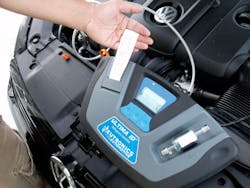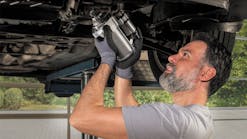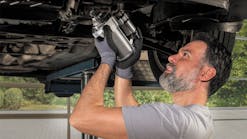You’ve heard me preach time and time again that it is imperative that you review and follow the OE recommended service procedures for any repair or service you are about to perform. System designs are in a constant state of change and even if you just completed a service on a 2012 model, that doesn’t mean it will be the same on that 2014 next on your hook.
Let’s talk a bit more about that with a slant on servicing A/C systems.
Close isn’t good enough
As with many of the vehicle’s systems, the air conditioning system has become more efficient than ever. This translated means that the service and repair processes you must follow are more precise than ever. The old days of “close is good enough” just don’t exist in our industry anymore. A/C systems of the last decade or so have reduced refrigerant capacities from pounds to ounces, and lubricant capacities on some models can be less than two ounces. Adding too much or too little of either can lead to premature failure of the compressor.
Speaking of compressor failure, what service steps do you follow when repairing the system after a compressor implodes? Microscopic parts of the compressor are scattered throughout and that new replacement you’ve installed is in for a short life should that debris find its way inside. While flushing the system is still approved by many manufacturers, the key to a successful flush is performing the task correctly and that can be time consuming, requiring removal of system components you’re better off replacing anyway. Consider a condenser with multiple flow paths or an evaporator that can’t be properly cleaned without removing it from the vehicle, and you can see that it’s going to be a costly job one way or another. Sure, you can do the minimum if you want to try to save your customer money, but how much does it save if they have to do it again a few years down the road?
Protecting yourself and your equipment
Another new reality that many are getting used to is having to deal with multiple refrigerants again. R134a has been around since the ’90s, and many R1234yf-equipped vehicles are out of warranty and showing up for repair at your shop. We may know there’s a difference but are you willing to bet the quality of your refrigerant supply that your customer (or their well-meaning DIY neighbor) does? Consider how expensive R1234yf is, and it isn’t hard to understand why a consumer may try to recharge the system on their own using R134a — or something worse, thanks to those experts on YouTube. (There is more than one showing how to use “Dust Off” — an aerosol for cleaning off your computer keyboard or other sensitive electronics - as a suitable automotive refrigerant.) You may counter with the fact that the system has unique fittings, as required by the Clean Air Act, but I’ll return that with a challenge — Google “adaptors to connect R134a gauges to an R1234yf” system and see what happens. The illustration used in this article looks like just the adapter a DIYer needs to connect a can of R134a (with sealant) that he/she purchased at the local big box store to their R1234yf system.
And that’s not the only cross contamination issue you may run into. Why do you think the R1234yf machine requires that a refrigerant identification be performed prior to servicing the vehicle? By the way, do you have a plan for recovering and disposing of any contaminated charge that shows up at your place? Even if you are servicing only R134a systems, performing the check prior to connecting to the car — let alone recovering the refrigerant charge — is always a good idea.
But before you do even that, test for the presence of sealant in the system. As you may have spotted in my earlier comment, many DIY products are being offered with sealant included. In fact, in the auto parts stores in my area, you have to look hard for a can or virgin refrigerant alone. To be honest, I don’t understand why when you remember that no OE that I’m aware of approves of its use in their vehicles. I certainly don’t want it in my A/C service equipment!
Maybe it’s not the charge
Computer-controlled systems with automatic temperature control is becoming more common, many allowing the passengers to modify the settings to their own personal preferences. Making this happen requires a variety of sensors and actuators, all having to work together in harmony.
Even now, the first thing I do when dealing with an A/C complaint of poor cooling performance, is to get in the car and set the controls for maximum output. I let the system run for a few minutes and then feel the temperature of the air coming out of the center vents with my hand.
If it isn’t cold, or even cool, my first thought used to be that the system must be low on refrigerant. That may not be the case when dealing with a system that utilizes numerous temperature sensors and air duct actuators. Today, it’s not a bad idea to connect your scan tool to the vehicle as you allow it to run and check the system for any stored DTCs (Diagnostic Trouble Codes). It’s also a good time to perform a full system scan to see if there are any other issues hiding that the customer may not know about. Finally, review the live data for the A/C system, especially the sensor readings, to see if any seem significantly different than what they should be.
A good example of this was a vehicle my good friend and training director for MACS (now the Mobile Air Climate Systems Association), Steve Schaeber, shared with me recently. The vehicle he was called in to look at had multizone climate control. The A/C would only work at maximum output or not at all. The shop that asked for the help had already performed several repairs in an effort to correct this problem, including replacement of the related control modules. A look at scan data revealed an internal temperature sensor reading 40°F, indicating a problem with the sensor. This one sensor alone prevented the A/C from operating unless the temperature settings were bypassed as they were in “Max A/C” mode.
Are you certified?
Certainly, it would be a great idea to have your ASE A7 certification under your belt before you tackle system diagnosis and repair but that’s not the certification I’m talking about here. Do you have your Section 609 certification?
Having this certification is required for anyone who services the refrigerant circuit for “consideration” — that is, you got paid something for the service. Even your neighbor that only charges a six-pack for his efforts is then legally required to have this card in his wallet.
Many of us have been certified for decades and if you’re one of them, don’t worry. That certification is still valid. However, I’m going to encourage you to retake the certification course and renew that card simply because of the added content and best practices now included in the program offered by MACS. And the cost is cheap enough.



